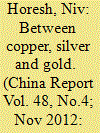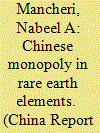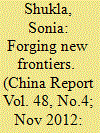|
|
|
Sort Order |
|
|
|
Items / Page
|
|
|
|
|
|
|
| Srl | Item |
| 1 |
ID:
117610


|
|
|
|
|
| Publication |
2012.
|
| Summary/Abstract |
The Revolution of 1911 in China not only put an end to the feudal monarchy that had lasted several centuries but also opened a new chapter, the era of republicanism in China. The founding of the Republic of China led to the proliferation of political parties, the thriving of legislative organs and the emergence of a cabinet system. However, historical evolution does not always conform to people's expectations. Revolutionary ideals could not be fully realised in a country which had been dominated by authoritarianism for thousands of years. As a result, Western-style democracy failed to take root in Republican China. Instead of embarking on a journey towards democracy, prosperity and independence, China gradually descended into a state where warlords took control and plunged the whole country into conflict.
|
|
|
|
|
|
|
|
|
|
|
|
|
|
|
|
| 2 |
ID:
117609


|
|
|
|
|
| Publication |
2012.
|
| Summary/Abstract |
This article provides the first comparative overview in English of Japanese colonial banks before World War II with an emphasis on their roles as banks of issue in Taiwan, Korea and Northeast China. It discusses at length similarities and differences in these banks' note circulation patterns, in their note-reserve requirements and their actual application, and in their geographical spread and respective colonial mandates. There was some variation in Japanese bank note issuance in the colonial setting of Korea and Taiwan, in 'Manchukuo' and in those parts of China that remained nominally sovereign. But all Japanese colonial banks seem, in one way or another, to have astutely adjusted the spread of their note issue in order to control for flagging demand due to nationalist boycotts, or to conversely cash in on demand spurts for notes resulting from crises in the indigenous financial sector. The banks of issue under review here were theoretically subject to a 100 per cent reserve requirement, but the make-up of their metallic bullion reserve and the degree of their notes' convertibility were very dissimilar, reflecting varying local conditions. Both in terms of reserve ratios, and note denominations-the banks prudently followed charter obligations that were devised by the Japanese Treasury but, at the same time, were reminiscent of the obligations that British overseas banks also had to abide by. Thus, the findings discussed here shed light on the inception and adaptability of Japanese colonial policy in the lead-up to the Pacific War.
|
|
|
|
|
|
|
|
|
|
|
|
|
|
|
|
| 3 |
ID:
117613


|
|
|
|
|
| Publication |
2012.
|
| Summary/Abstract |
The concentration of rare earth elements (REEs) production in China raises the vital issue of supply susceptibility. Until recently, the global dependency on China for rare earths was a well-kept secret. But word started to spread fast after Beijing cut export quotas by 70 per cent for the second half of 2010, sending prices of some oxides-the purified form of rare earth elements sky-rocketing. This article seeks to evaluate what rare earth elements are and explores China's role in the global supply-demand equations. It also explores the history of rare earth elements and China's current monopoly over the industry, including possible repercussions if rare earth elements supply were to be disrupted.
|
|
|
|
|
|
|
|
|
|
|
|
|
|
|
|
| 4 |
ID:
117611


|
|
|
|
|
| Publication |
2012.
|
| Summary/Abstract |
With the departure of the British from South Asia in 1947, the transition of the NEFA (North East Frontier Agency, later Arunachal Pradesh) border from the colonial to the post-colonial era followed a predictable and conventional geopolitical script. India began consolidating its frontiers to create borders where none had existed. It adopted a restrained policy of non-interference, in which local traditions-political, cultural and social-were respected and protected. Institutional support and effective policy implementation proved to be the tools that made NEFA, including parts of it that had hitherto never been administered by British India, a part of modern India. The article draws on hitherto unpublished field research carried out in the Tawang tract to tell an oral history account of the integration of Tawang from the perspective of the local people. It draws on more than a hundred conversations with the people in the region and the author's access to local administrative documents, and locally published materials to examine India's approach towards local identities as New Delhi began the process of administering Tawang in 1951.
|
|
|
|
|
|
|
|
|
|
|
|
|
|
|
|
| 5 |
ID:
117612


|
|
|
|
|
| Publication |
2012.
|
| Summary/Abstract |
This article analyses the stages of evolution of local democratisation in rural China from the perspective of innovation, especially grassroots innovation studies. Based on an interpretation of four major cases of villagers' political innovations over the past three decades in rural China, we argue that: (a) villagers' collective action triggers political reform in rural China; (b) the interaction between villagers and the government/Party moves the process of rural political innovations forward; and (c) the innovation process model drawn from the field of grassroots innovation studies, consisting of four stages-problem/motivation, trigger, initiative/innovation and diffusion/impact-explains the trajectory of institutional change in rural politics just as it explains the trajectory of grassroots technological and economic institutional innovation.
|
|
|
|
|
|
|
|
|
|
|
|
|
|
|
|
|
|
|
|
|